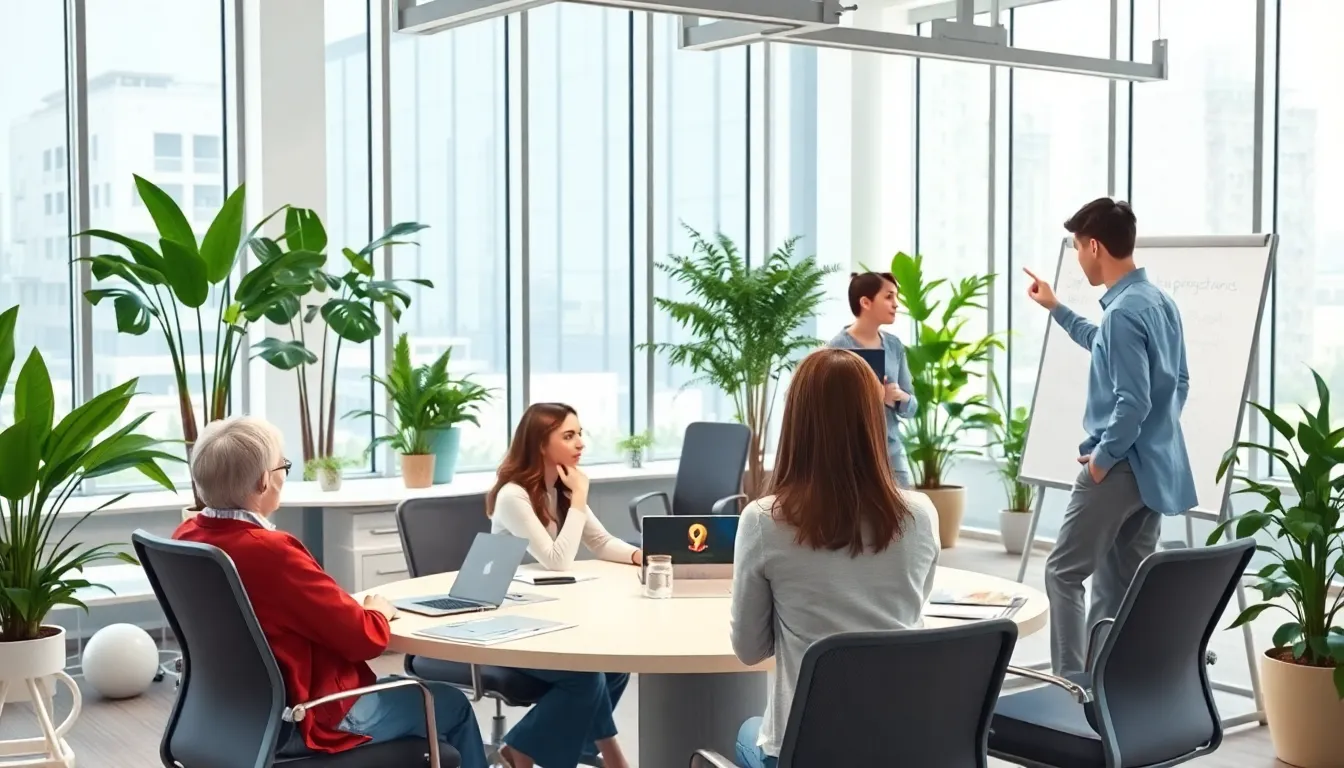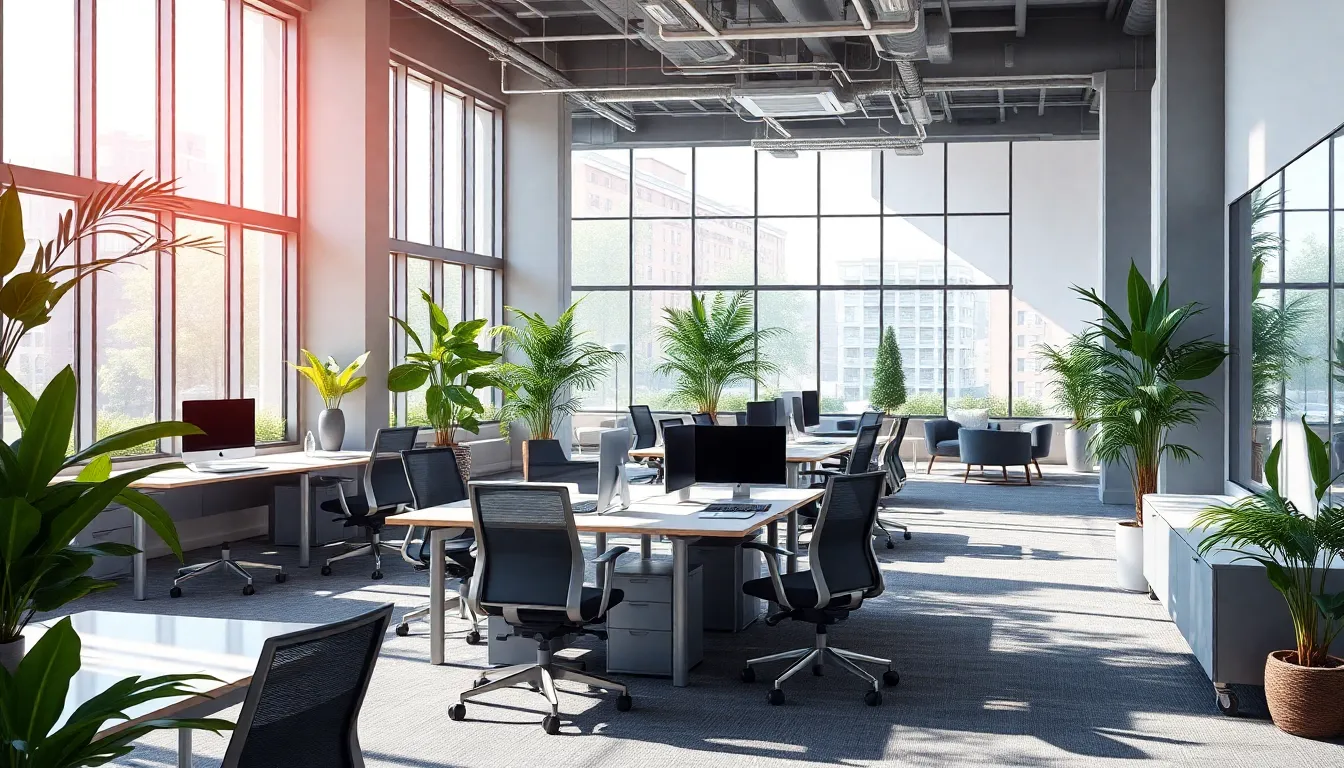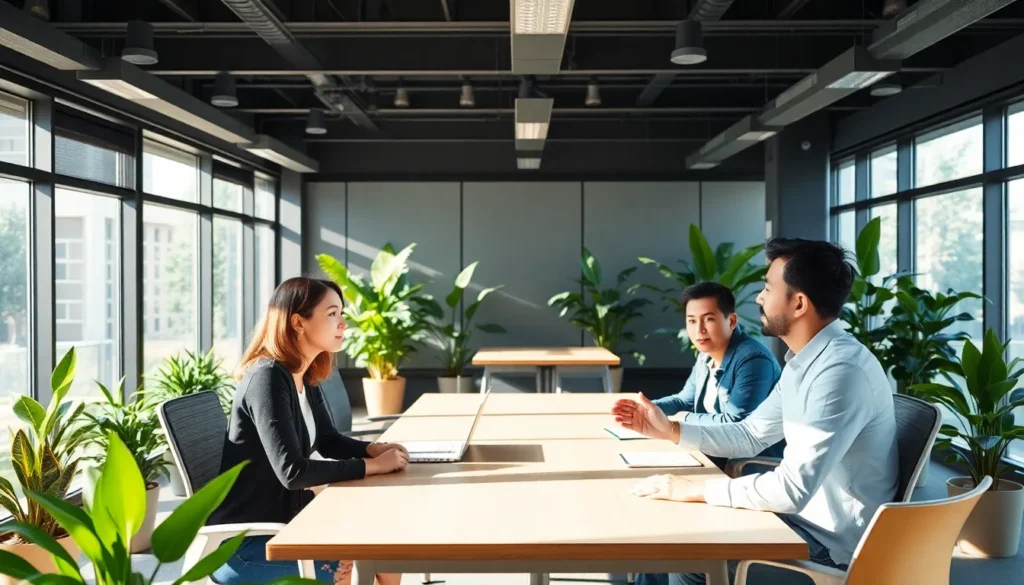In a world where the office is no longer just a place to clock in and out, the design of these spaces has become a hot topic. Gone are the days of drab cubicles and flickering fluorescent lights. Today’s office design trends are all about creating environments that inspire creativity, boost productivity, and maybe even make employees forget they’re at work.
Office Design Trends
Current office design trends emphasize flexibility and adaptability. Open floor plans emerge as a popular choice, promoting collaboration among employees. Many organizations now incorporate biophilic elements, such as natural light and plants, to enhance employee well-being.
Color schemes play a crucial role in setting the tone of the workspace. Vibrant colors can stimulate creativity, while muted tones provide a calm ambiance. Ergonomic furniture is becoming essential, as it supports employee health and comfort during long work hours.
Technology integration shapes modern office spaces. Smart solutions like adjustable lighting and temperature control create a customizable environment tailored to individual needs. Collaborative spaces, like breakout areas and meeting pods, encourage teamwork and innovation.
Sustainability influences many design decisions. Eco-friendly materials and energy-efficient systems minimize environmental impact. A growing number of companies prioritize wellness features, including fitness areas and relaxation zones, signaling a shift towards holistic employee care.
A focus on remote work has driven changes in office layouts. Hybrid working models demand environments that cater to both in-office and remote employees. These adaptations require versatile spaces that foster connectivity, ensuring remote workers feel included.
Finally, aesthetic appeal continues to be a focal point in office design. Unique art installations and personalized workspaces contribute to a vibrant atmosphere. Such elements not only enhance the visual appeal but also reflect the company culture and values.
Importance Of Modern Office Design


Modern office design plays a crucial role in shaping work environments. Focus shifts towards creating spaces that support employee needs and preferences.
Enhancing Employee Well-Being
Employee well-being stands as a priority in contemporary office settings. Incorporating natural light reduces stress levels and enhances mood. Spaces filled with greenery lead to increased feelings of relaxation and creativity. Providing quiet areas allows workers to recharge, improving overall satisfaction. Wellness features like fitness areas contribute to physical health, promoting balance in professional life. Personalization of workspaces increases comfort and makes employees feel valued.
Boosting Productivity
Productivity often flourishes in well-designed offices. Open floor plans encourage collaboration, facilitating idea exchange. Ergonomic furniture ensures comfort, allowing workers to focus on tasks rather than physical discomfort. Effective color schemes stimulate creativity and concentration, influencing overall output. Technology integrations simplify processes and improve efficiency. Also, breakout areas promote teamwork and innovation, breaking monotony. By blending aesthetics with functionality, modern designs inspire motivation and drive success.
Popular Office Design Trends
Current office design trends emphasize creating environments that support employee productivity and well-being. Notable changes include layouts and aesthetics that focus on collaboration, comfort, and technology.
Open Plan Layouts
Open plan layouts encourage teamwork and interaction among employees. These spaces remove barriers, facilitating communication and the exchange of ideas. Additionally, they promote a culture of inclusivity and transparency within the workplace. Challenges associated with noise and distractions are addressed through acoustic panels and designated quiet zones for focused work.
Biophilic Design
Biophilic design prioritizes the incorporation of natural elements into office spaces. This design philosophy aims to connect employees with nature, which enhances mental health and reduces stress. Incorporating living plants, natural light, and water features contributes to a calming atmosphere. Wellness improves when employees can enjoy views of greenery, fostering creativity and relaxation throughout the workday.
Flexible Workspaces
Flexible workspaces adapt to the changing needs of employees and projects. Companies offer various settings, such as open areas, private offices, and collaborative spaces, designed for specific tasks. Such versatility accommodates remote workers and their diverse working styles. Comfortable furniture and adjustable configurations further enhance these adaptable environments, supporting both individual focus and group work.
Technology Integration
Technology integration shapes modern office designs to enhance functionality. Smart solutions, like adjustable lighting and temperature control, create customizable environments that meet employee preferences. Additionally, advanced communication tools and video conferencing equipment foster collaboration among teams, whether in-office or remote. By utilizing technology effectively, companies streamline workflows and improve overall productivity.
Future Predictions In Office Design
Future office design leans heavily toward sustainable practices and adaptability, reflecting changes in work culture.
Sustainability Trends
Sustainability trends reshape office environments by integrating eco-friendly materials and energy-efficient systems. Companies increasingly opt for recycled products and low-VOC paints, minimizing environmental footprints. Solar panels are installed on rooftops to harness renewable energy, while green roofs improve insulation. Additionally, water-saving fixtures contribute to conservation efforts. Spaces incorporate natural elements, including plants that enhance air quality and employee well-being. Urban agriculture initiatives within office buildings bring fresh produce closer to employees. Overall, prioritizing sustainability not only benefits the planet but also elevates brand reputation among conscious consumers.
Remote Work Adaptations
Remote work adaptations influence office design by fostering hybrid work models that accommodate both in-office and remote employees. Designated areas within offices allow for collaborative sessions, while private phone booths support virtual meetings. Flexible furniture arrangements enable easy reconfiguration for various activities, maximizing space utilization. Effective technology solutions, like high-quality video conferencing tools, bridge the gap between in-office and remote teams. As organizations embrace this shift, layouts prioritize community and connectivity, creating environments that support collaboration, whether on-site or from afar. Embracing these adaptations optimizes the employee experience, keeping everyone engaged and aligned.

